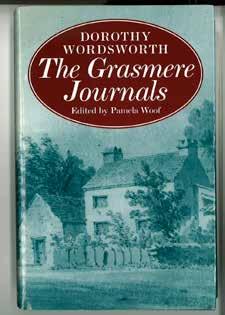
3 minute read
THE GRASMERE JOURNALS
When she is far from England and feeling homesick, the poet Fleur Adcock turns to the journals recording the changing seasons in the Lake District by a keen observer of nature.
Dorothy Wordsworth’s Grasmere Journals has long been my desert island book because, apart from the inimitable companionship of Dorothy herself and the other characters she mentions, it comes with its own built-in geography; the two editions I possess even contain maps. I may imagine myself lying on some boring tropical beach and, as I watch the inexorably rising sea, taking consolation in a mental walk along one of Dorothy’s favourite routes and hearing her say, having refused an escort home: ‘This was very kind, but God be thanked, I want not society by a moonlit lake. ’ The journal also provides therapy for that ‘Oh to be in England’ feeling in the less fanciful context of prolonged visits to New Zealand where, even in the company of my much-loved extended family, there are times when my subconscious feels outraged by the ridiculousness of Christmas in mid-summer and unnatural dislocations in the patterns of seasonal vegetation. Dorothy was a reliable annalist of the comings and goings of plants.

In September 1977 I took up an Arts Council writer’s fellowship at Charlotte Mason College in Ambleside and began discovering the Lake District. I bought my first copy of Mary Moorman’s edition of Journals of Dorothy Wordsworth (1971) in the Dove Cottage bookshop in Grasmere, kept it on my bedside table, and when I had reached the end went back to the beginning. When it was worn out I bought another copy, which kept me going until Pamela Woof’s excellent edition, The Grasmere Journals, came out in 1991. The journal does not date, except superficially: when my friend Angela Carter came to spend a weekend with me in May 1978 we went on a nature walk and found all but one of the wildflowers Dorothy recorded on the first page of her journal in May 1800. (Angela was much taken with the Wordsworths’ domestic relationships, and wrote an irreverent essay about them.)
Dorothy had been, like me, an excited newcomer to the Lake District when she arrived to set up house in Dove Cottage, Grasmere, with her two brothers, William and John, at the end of 1799. Having lost her mother at six, she had been shunted from one relative to another, scarcely getting to know her brothers. Her passionate sensibility and eager responsiveness were perfectly suited to the situation in which she now found herself: in a place of spectacular natural beauty and with the companionship of a poet-brother who would appreciate her detailed and ecstatic descriptions of it. She began her journal on the day he and John (a sea captain who was to die in a shipwreck in 1805) set out on foot for Yorkshire in May 1800. It was first published as The Journals of Dorothy Wordsworth in 1897.
Everything is in it: she walks daily to Ambleside for the post, bakes bread and pies, has headaches, talks to neighbours, gathers flowers and mosses for their garden; William plants peas and works on a sonnet; Coleridge walks over Helvellyn to visit them; their swallows build a nest, it falls down (‘Poor little creatures they could not themselves be more distressed than I was’), they build another; beggars call at their door, and William uses Dorothy’s account of them in a poem. It is all absorbingly real.
Her journal covers less than three years. My own stay in the Lakes lasted scarcely one, but by the end of it I had become ‘hefted’ to that particular patch – Ambleside, Rydal, Grasmere – like a Herdwick ewe that could return to it instinctively even after long absence. My visits these days are not very frequent, but Dorothy’s journal is established in my head: a refuge for whenever I may feel I’m in the wrong place.


